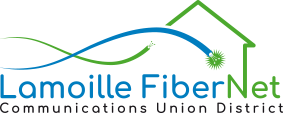DSL, cable and fiber. What’s the difference?
October 25, 2021 – DSL, cable, fiber – what is all this stuff? When the internet was new, getting connected was a luxury. The sound of a modem negotiating a “handshake” to the answering modem was exciting. Everyone’s speeds were very similar unless you were one of the lucky folks who could afford ISDN or a T1 connection.
Today we are presented with many different options for connecting to the internet. If you are connected to wired services, you might have DSL (Digital Subscriber Line) or Cable. If you are one of the very lucky ones, you will have Fiber. The folks who are not connected to services have to rely on satellite internet or wireless internet, both of which present some challenges and shortcomings.
Why Fiber?
Of all the ways to connect to the internet, it is Fiber that provides the greatest bang for the buck—fiber transmits data via light, i.e., at the speed of light. Also, with DSL and Cable, your upload and download speeds are always lopsided. DSL might be 7mb (megabyte) for downloading data, but only 500k (kilobyte)sending or uploading data. If you have a good DSL connection that might be 25/3 (25mb down and 3mb up). Cable is much the same with much faster speeds like 250mb down and only 12mb up. The upload speed is important for when you are sending files to the Cloud or uploading content to a website, for example.
Fiber connections are “symmetrical,” meaning if you get 250mb for downloads, you get 250gb for uploads. Gigabit packages (one gigabit is 1000 times one megabit) are common with fiber, and the speeds are 1gigabit down and 1gigabit up. Also, fiber is capable of transmitting MUCH faster speeds. As new electronics and protocols are created, fiber can be used to create faster and faster connections. Terabytes (one terabit of 1,000,000 times one megabit) of data can be transmitted over fiber, although those connections are in data centers with very expensive and specialized equipment.
One more thing – latency
Latency is another important factor when it comes to your internet. Latency is the time it takes for data to be transferred between its original source and its destination. Latency is measured in milliseconds, and while cable and DSL have pretty good latency times (30ms-100ms), fiber can have .17ms latency. This improves video calls, VoIP (voice over internet protocol, in which you use the internet for your phone service), and gaming. If you notice hiccups or dropouts on your internet connection, this is often caused by latency.
Lamoille FiberNet Communications Union District is committed to bringing affordable, symmetrical fiber internet connections to ALL of the unserved or under-served residents of Lamoille County.
The mission of Lamoille FiberNet Communications Union District (LFCUD) is to make locally controlled, affordable and reliable high-speed internet service available to every address in our member towns – Belvidere, Cambridge, Eden, Hyde Park, Johnson, Morristown, Stowe, Waterville and Wolcott. For more info, go to http://www.LamoilleFiber.net.




